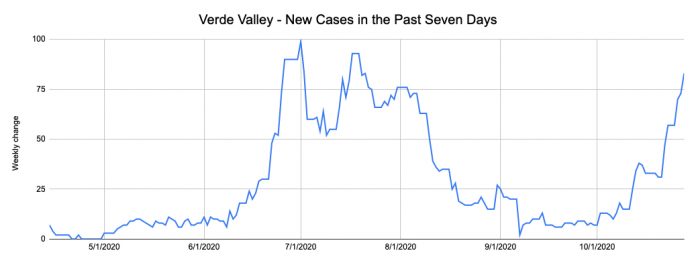After a spike in the early summer, the spread of the novel coronavirus in the Verde Valley was low for most of the late summer through early fall, dropping as low as just two new positive tests in a week in early September.
However, recent trends indicate that the fallow period may be over, as numerous communities have started to see an increase in new cases.
In the week between Wednesday, Oct. 21, and Wednesday, Oct. 28, there were 83 new COVID-19 cases in the Verde Valley, the highest one-week increase since mid-July, though still slightly below the highest rate of spread in June.
The biggest increase came in Cottonwood, which had 31 new cases in the previous week, bringing the city’s total since the beginning of the pandemic to 343.
Camp Verde had 21 new cases in the same time period, with a total of 130, Sedona had 15 new cases and a total of 130, and Rimrock had nine with a total of 63.
Other places in the Verde Valley have not seen the same spread yet, with Clarkdale seeing just three new cases and Cornville seeing just six in the past week, bringing their totals to 74 and 46. The Village of Oak Creek holds steady at 39 and and “other” went up by one to three total.
“We have some concerning trends right now. We are seeing an uptick in the Verde Valley cases,” Yavapai County Community Health Services Director Leslie Horton said. Horton said her biggest concern is the discovery of coronavirus cases at three assisted living facilities in the county, including at least one at Sedona Winds in the Village of Oak Creek. “Those are probably our highest risk groups.”
While the number of cases in the area is increasing, the rate of hospitalizations has not yet spiked in the same way. As of Oct. 25, Verde Valley Medical Center had just five COVID-positive cases, far below the 23 that the hospital experienced at the height of the previous wave, but still above last week, when it had just one case. Hospital administrators say that the past few months of fighting the pandemic have left the medical staff more adept at fighting the virus, and they believe they can better deal with patients who do come in.
“We’ve gotten better at treating this,” Dr. Derek Feuquay, chief medical officer at Flagstaff Medical Center told reporters on a Northern Arizona press call. “Early on, ‘Don’t use steroids’ was one of the things that we were told, because that made it worse. What we’ve found as time goes on is that’s one of the most effective treatments that we have. We’ve also found Remdesivir to be effective and we treat patients with that …. We’re just getting better at it.”
Public health officials nevertheless warn that even if the virus is becoming less deadly due to improved treatment, it remains dangerous, especially when it reaches populations with other complicating factors, such as older people or people with compromised immune systems. Horton expressed concern
that many people are passing the virus from generation to generation within households and insisted that when a family member tests positive, all members of the household should quarantine in order to prevent the spread.
“If a healthy 30-year-old with a low chance of dying contracts COVID, there’s a chance they’ll transmit it to someone with a higher chance of dying, like a 70- or 80-year-old,” VVMC Chief Medical Officer Leon Pontikes said, while stressing as well that some younger and seemingly healthy patients have ended up seriously ill or dying from the virus as well. “It’s highly contagious.”
Horton warned people not to lower their guard in fighting the virus despite the long time that has been spent under precautions.
“We just want to make sure that as a community we place an emphasis on doing what we know works — not convening in large groups of people, being very careful with big groups of people, avoiding house parties,” Horton said. “I think we are seeing some increases, and to me it is concerning. There’s a lot on the line for meeting the metrics that the state has placed for schools and businesses reopening. We want them to remain open.”



